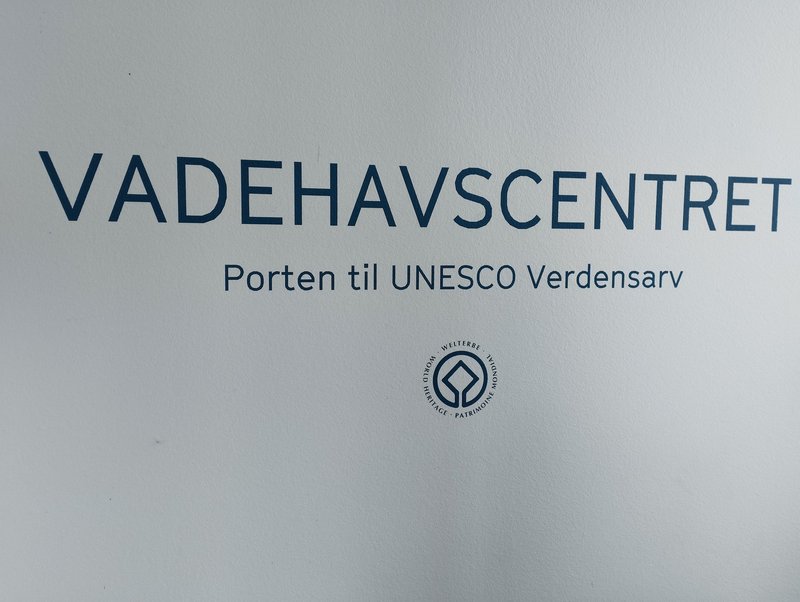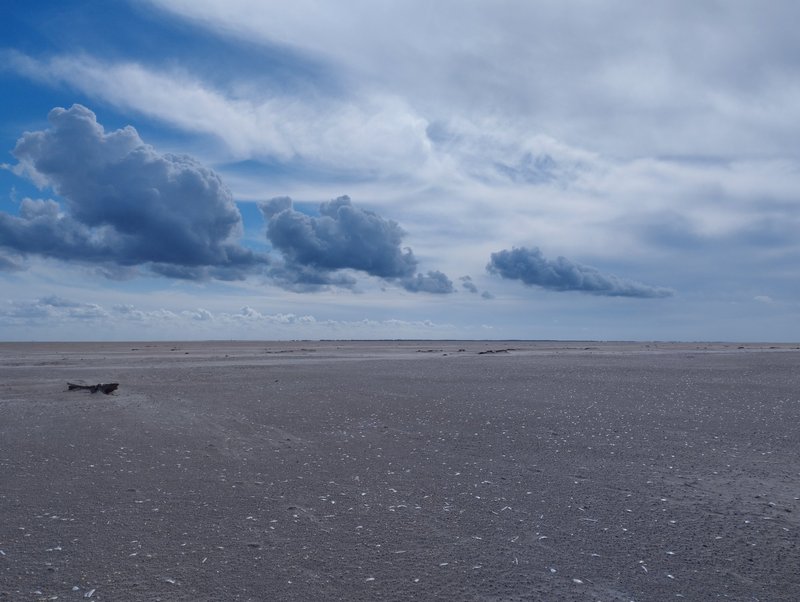The sand glistened like mercury ahead of me, wet and silver. Mussel and razor clam shells crunched beneath my feet as I walked, following a line of gull footprints, the only tracks in an otherwise trackless expanse. Rivulets of water still flowed out to the west, to the visible blue that marked the edge of the North Sea. In the other direction a far-distant, darker, fringe of land seemed to shimmer like a mirage across the sand. And behind me stood the bus from which I had just disembarked, twenty minutes off shore.
If you type in ‘Koresand’ on Google Maps, it finds the location perfectly, but just shows it as an uninterrupted patch of blue sea south west of the Danish island of Mandø. I feel that the maps used on this website do me a bit dirty by more accurately showing what looks to be a patch of sand, with even a couple of tracks making their way onto it. This was where I was.
The Danish section of the Wadden Sea has been rather under-discussed here compared to the original Dutch and German sections which is rather a surprise as it can be accessed very easily. The entire western coast of Jutland from south of Esbjerg down to the German border falls within the Wadden Sea National Park (Nationalpark Vadehavet). And a visitor’s centre, the Vadehavscentret, sits just outside the village of Vester Vedsted, less than 20 minutes drive south west of the pretty and historic city of Ribe. From here if you walk west, over the protective dyke, until you get your feet wet, then congratulations! You’re in the Wadden Sea.

The Vadehavscentret has plenty of WHS symbols and describes itself as ‘Porten til UNESCO Verdensarv’ but staff could not point me to an actual ‘plaque’. It houses a café, a small shop, and an exhibition (entrance 140 kroner for adults, 50 for children) focussing on the natural environment: the floodtides, the foodchain, the migratory birdlife, memories of local culture. The entry fee is a bit steep in my view, but my kids liked the touchpools of crabs and flatfish, the games, and the ability to mix birdsong into DJ tracks (!). More to the point, it also operates tours into the Wadden Sea, from foraging and collecting oysters to eat, to birdwatching or seal safaris, to guided hikes or cycle tours (all of which also grant you a 20% discount on entry to the Centre itself). We booked on for what is referred to as a ‘Desert Tour to Koresand’. A name which – once I had experienced the expanse of sand with mirages hovering on the horizon – made a lot more sense. Note that tours may not leave at the same hour every time, as they are often dependent upon the tides.
I mentioned above that we travelled by ‘bus’. The Mandøbus is a tractor pulling a trailer in which passengers sit. This leaves from the Centre and heads firstly for the island of Mandø. Note that the island is itself excluded from the inscribed site. However, the road there is. Though perhaps the word ‘road’ is as misleading as the word ‘bus’ was. A gravel trackway has been laid across to the island. At high tide the causeway is covered by the sea, cutting off the island, and winter storms can destroy it. So if you are walking, cycling or driving yourself, please pay attention to the tide timetables. The spreading gravel, flanked by swathes of marsh grass, lies in the core zone and was really interesting. Late summer swallows swooped over the grass, flocks of small brown dunlins took flight from the mudflats where orange-beaked oystercatchers (so numerous that they are even called mandøpigen locally) prowled, shaggy cormorants could be seen perching on posts, tall white egrets and smaller grey herons stalked the water. We even caught a sight of a juvenile white-tailed eagle in the distance. We travelled over the dykes onto the island of Mandø, whose permanent population is now only 27, and then off the other side into the shallow water and across to Koresand.
Over on the sandbank, with the clouds drifting overhead, the bus made three stops. The first was unscheduled – our local driver had noticed something interesting lying on the sand. Closer inspection revealed it to be a dead porpoise, skin stretched tight over its bones. The second was just after we had seen a harbour seal pup galumphing its way down to the water ahead of us, startled by our arrival. Here, on an expanse of shell-covered sand, the children could collect findings – mussel, cockle, razor clam, whelk and Pacific oyster shells, mermaid’s purses, cuttlefish bones. The last was at an inlet where water still flowed down to the North Sea. Armed with shrimping nets we were able to collect a surprising amount of biomass in just ten minutes – mostly brown shrimp, but also a few pipe fish. Then it was back on the bus, back over Mandø, and back to the mainland. This time we took the old route that predated the gavel causeway, driving across the mudflats in a curving line marked with birchstalks, gulls following our journey. This route would have been impassable when we first arrived, and had only been revealed by the falling tide.

It was a really worthwhile day out, and I think it managed to show and explain several of the key features of the site whilst taking us really far out into the core zone. While my kids loved collecting shells and shrimps, I’ll admit that they may have had a minor mutiny if we hadn’t have seen the seal pup, so maybe a specific seal safari might have been better for them. For myself, I’d maybe have preferred a birdwatching tour along the causeway and through the marshes. But all those options are available through https://www.vadehavscentret.dk/en/tours-and-activities/ and I think its estimable that there is so much variety in things to do to experience the Danish Wadden Sea. I’d advise people to check it out – as they say at the Vadehavscentret, 15 million migratory birds can’t be wrong!
Visted August 2025
World Heritage-iness: 3
My experience: 3.5
More on
Comments
No comments yet.
